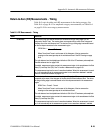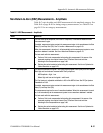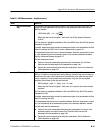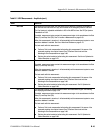
Appendix B: Automatic Measurements Reference
CSA8000B & TDS8000B User Manual
B-37
Non-Return -to-Zero (NRZ) Measurements - Amplitude
Table B--7 topic describes each NRZ measurement in the amplitude category. See
Table B--8 on page B--50 for timing category measurements.; see Table B--9 on
page B--55 for area category measurements.
Table B- 7: NRZ Measurements - Amplitude
Name Definition
NRZ AC RMS The root mean square amplitude, minus the DC component, of the selected waveform within
the measurement region.
If enabled, measurement gates constrain the measurement region to the area between the Start
Gate (G1) and Stop Gate (G2). See To Localize a Measurement on page 3--83.
When this measurement is turned on, it will automatically set the measurement system to use a
waveform database if available. See Use a Waveform Database on page B--70.
For best result s with t his measurement:
H Perform a Dark Level compensati on before taki ng this m easurement if the source of the
measured waveform is an optical channel. See To Perform Dark-Level and User
Wavelength Gain Compensations on page 3--98.
H Optimize the vertical resolution before taking this measurement. See How to Optimize the
Vertical Resolution on page B--70.
NRZ Amplitude The difference between the logical 1 level (High) and the logical 0 level (Low) of the NRZ signal.
Both High and Low levels are measured wi thin the Eye Aperture.
NRZ Amplitude = High – Low
Where High and Low are the logical 1 and 0 levels.
The Eye Aperture is adj ustable and defaults to 20% of the NRZ bit time. See RZ Eye Aperture
Parameters on B--62.
If enabled, measurement gates constrain the measurement region to the area between the Start
Gate (G1) and Stop Gate (G2).
This measurement requires the use of a waveform database. When this measurement is turned
on, it will automat ically set the measurement system to use a waveform database if available.
For best result s with t his measurement:
H Perform a Dark Level compensati on before taki ng this m easurement if the source of the
measured waveform is an optical channel. See To Perform Dark-Level and User
Wavelength Gain Compensations on page 3--98.
H Optimize the vertical resolution before taking this measurement. See How to Optimize the
Vertical Resolution on page B--70.


















